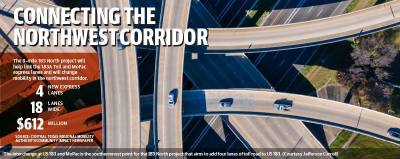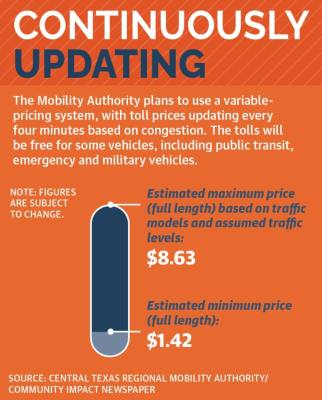That growth has brought changes to the transportation network surrounding US 183 where the Central Texas Regional Mobility Authority is planning a $612 million expansion between SH 45 N/RM 620 and MoPac. The project broke ground Jan. 26.
“[The project is] not going to be perfect, but it’s something that’s well overdue to be done,” said Denney, who is the president of the Anderson Mill Neighborhood Association.
The 9-mile project, which is receiving $104 million in funding coming from the Texas Department of Transportation, will add a total of four express toll lanes and two general-purpose lanes, making it••18 lanes wide in some areas.
While his commute takes him to Bee Cave, Denney said he often goes downtown and sometimes uses the MoPac express lanes. He added that the project’s construction could lead to more Northwest Austin residents using Capital Metro to commute.
“It might actually get more people to start looking at [Capital Metro] as an alternative, as long as the bus schedule is predictable,” Denney said.
Those express lanes, which are separated toll lanes that have no cost for public transit, emergency response and military vehicles, will connect 183A Toll to the MoPac express lanes. Eventually, the toll road network will extend from downtown Austin to Liberty Hill, once the 6.6-mile 183A Toll Phase 3 completes in 2025.
To pay or not to pay
Experts say express lanes are one of the most effective mechanisms to make roads work better. Michael Manville, a professor of urban planning at UCLA, said he favors tolls because they force drivers to consider the time involved and how they make trips.
“If you just changed the behavior of a small number of people who might get on that road, the road works a lot better, carries more people, there’s less congestion and you actually have a high-quality service,” Manville said.
He said tolls are an effective way to pay for highways, and the people who benefit from them are the ones who drive on them.
“If you charge someone per use, much the same way that we meter water, meter electricity and so forth, the people who are using it pay for it, and that’s how you actually finance this infrastructure,” Manville said.
Jay McNabb lives in Cedar Park and works for a sign company, a job that has him travel throughout the Austin area. He said he sees the express lanes as an important tool to get places faster and often uses the express lanes on MoPac.
“The express lanes make a huge difference because you’re not fighting people getting on and off,” McNabb said.
He said he is optimistic the Mobility Authority will not drastically change his commute along US 183 during the construction project.
Diverting business traffic
However, some business owners in the region are less enthused about a project that will bring five years of construction and add 9 miles of toll roads.
Carla Kirkwood and Deneise Raines have a combined 90 years of experience working in the floral industry. They took over ownership of Flowers Flowers Inc., located near the US 183 and Anderson Mill Road intersection, 18 years ago.
The pair worked at the shop during the project that transformed US 183 into a highway in the 1990s and early 2000s and worry the new project could be similarly disruptive for their operation.
“Let’s just say this little project is not going to be our friend,” Kirkwood said.
She said she is concerned about drivers taking alternative routes that would take them away from the Flowers Flowers Inc. storefront.
“People are not going to be wanting to come around here, so they’re going to go and they’ll take Parmer [Lane], and Parmer takes them not by our shop,” Kirkwood said.
Ken Le, owner of Galleria Nails, has been in his location for one month, and, like Kirkwood, he expressed skepticism about the need for the project and its impact on local businesses. Compared to I-35 near downtown Austin, Le said traffic on US 183 is pretty manageable.
“I wonder why are they doing this because this road does not really seem to [have] much traffic,” Le said.
He said he doubts the project will actually complete in five years.
“[They say] a lot of roads [will take] five years, [but it takes] them like 10-20 years and [they’re] not even finished,” Le said.
Construction phasing
Mike Sexton, who is the acting director of engineering for the Mobility Authority, said the project will move along in phases. In the first phase crews will prepare the median area for pavement as well as constructing bridges and sidewalks.
The second phase, likely to begin in late 2022 or early 2023, will see traffic shift to the newly created lanes in the highway’s median. The construction of the bridge connecting the new express lanes and the MoPac express lanes will also begin in 2023.
Sexton anticipates the different sections of the project will likely advance at different paces. That means drivers could be in the newly constructed lanes in the former median for some stretches and on the outside lanes for others as the work advances.
Once opened, the tolls will use a variable-pricing system, which will update the cost every four minutes based on congestion, which is similar to how the MoPac express lanes •operate. The goal of the system will be to maintain speeds of at least 45 mph in the express lanes, Sexton said.
More than cars
While Manville said he sees advantages in express lanes, he is skeptical the project will actually reduce congestion. He said adding lanes will induce demand—the idea that creating more supply of roads will cause more people to use them.
“The efficient thing to do if you had a six-lane highway is just take two existing lanes and say, ‘Look, now they’re tolled and anyone who doesn’t want to pay those tolls now still has four lanes they can travel,’” Manville said.
Transit advocates say a project focused on creating walkable and bikeable spaces along Capital Metro’s MetroRail Red Line, said the express lanes in general are a smart way to reduce congestion and could help public transit because buses would not have to pay to use them.
Capital Metro similarly sees advantages to the project for improving its service.
“The express lanes are a benefit to our customers and community as they help Capital Metro provide more efficient and reliable commuter bus service,” Capital Metro spokesperson Jenna Maxfield said in an email.
She said that because of the construction and a MetroExpress bus schedule still reduced by the pandemic, customers should consider using the MetroRail Red Line that has Leander and Lakeline stations.
Despite some benefits for public transit, Tom Wald, the executive director of the Red Line Parkway Initiative, said the project could have included more elements recommended in a 2017 study funded by the Mobility Authority.
The Near Northwest Corridor Connections Case Study carried out by the Capital Area Metropolitan Planning Organization recommended a parallel bicycle network to US 183. It stated that creating a safe environment for bicyclists on the frontage roads within 10 to 20 years would be “infeasible” due in part to the high volume of high-speed traffic on those roads.
In its current design, the project will add 1.5 miles of bike lanes; a half mile of shared-use path, essentially a wide sidewalk; and 11 miles of reconstructed or new sidewalks.
“The scope of the project is to expand the main lanes and not really touch the frontage roads, and so the argument was made that, as part of the scope of the project, they’re not really going to make any substantial improvements for bicycling or walking,” Wald said. “For bicycling, currently the accommodation is that if you need to get to a destination along that corridor, you bike on the frontage road, where the speeds are typically 40-70 [mph].”
Sexton said the project will add connections for bicyclists between Pond Springs Road and Jollyville Road as well as a section on Lake Creek Parkway. However, he said the agency only had so much space in the right of way to increase bicycle and pedestrian options.
“When you get into these tight urban corridors, you just get limited on right of way,” Sexton said.
He said expanding sidewalks within the project’s current design would have required acquiring property from businesses.
Despite space limitations, Sexton said he is optimistic about the project and said it will provide drivers with more options.
“We’ve always believed that the express lane option is considered a less frequent choice for most consumers. You need to get home for your kid’s football game; you need to get to the day care and emergencies. It’s more of a one-off experience than it is necessarily a daily commute experience in many cases,” Sexton said.
Editor's note: This article was updated to clarify information attributed to Tom Wald. This article is part of the 2022 Annual Community Guide for Community Impact Newspaper's Cedar Park-Leander and Northwest Austin editions.









